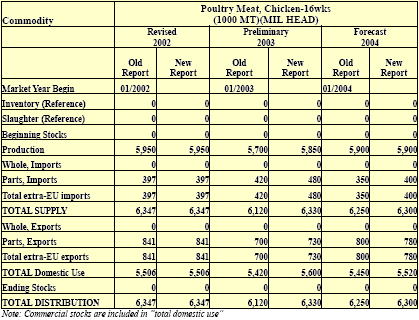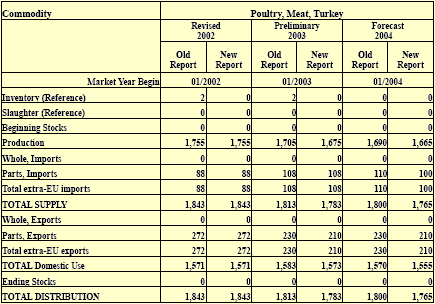



EU Poultry and Products Semi-Annual Overview - January 2004
By the USDA, Foreign Agricultural Service - This article provides the poultry industry data from the USDA FAS Poultry and Products Semi-Annual 2004 report for the European Union. A link to the full report is also provided. The full report includes all the tabular data which we have ommited from this article.Report Highlights:
In 2003 overall EU poultry meat production decreased. The decrease was mainly caused by the summer heat wave and the outbreak of the Avian Influenza in the Netherlands.
The current outbreak of Avian Influenza in South East Asia makes the 2004 forecast difficult, however a large share of the imported chicken meat from Thailand is cooked poultry product, which is not expected to be severely effected by the EU embargo.
Executive Summary
In 2003, the EU Poultry sector decreased from previous levels. The decrease was mainly caused
by the summer heat wave, the outbreak of the Avian Influenza in the Netherlands as well as by the
continuing decline in French poultry production.
In 2004, EU Poultry production is expected to increase as the Netherlands is recovering from
Avian Influenza. French, Italian and to a certain extent Spanish production is expected to
continue to decrease. Overall EU imports are expected to decline, due to the complete closure of
the loophole on imports of salted poultry meat and the impact of the EU embargo on Thai poultry
meat. Overall EU chicken meat exports are expected to grow since Dutch exports are expected to
resume. EU turkey meat exports are expected to remain stable. Domestic consumption is
expected to continue the normal trend, slightly increasing.
Also in 2004 the effects of Enlargement and of the CAP-reform will start. In the accession
countries there is a tendency toward growing poultry consumption. There is also uncertainty
concerning the degree of integration slaughterhouses from CEEC1 countries will have onto the
current EU-15 market. As a result many of the poultry products produced and slaughtered in
these countries may not be immediately eligible to be placed on the current EU-15 market.
Due to the current outbreak of the Avian Influenza in Thailand and the subsequent ban on Thai
exports of poultry to the European Union, the poultry situation is somewhat difficult to forecast.
Most of the imported chicken meats are however cooked poultry products, which are not expected
to be effected by the embargo. It is forecast that in 2004 there will be fewer chicken imports into Germany, the UK and the Netherlands. However Brazilian imports are expected to compensate
for some effects of the Thai poultry ban.

In 2003, the overall EU chicken meat production decreased from previous levels, but not as much
as previously forecast. The effects of the Avian Influenza outbreak in Netherlands in the spring of 2003 and last summers heat wave were less severe than earlier anticipated. Production decreased
in Netherlands, Italy and France, while production increased in Germany and the UK. The
increase in production in Germany was also indirectly due to Avian Influenza since many German
broilers were slaughtered in Germany instead of sent to the Netherlands for slaughter. The
decrease in French production is mainly due to sluggish demand, both domestically and abroad.
Imports in 2003 increased in Germany, Spain and Italy. The strong increase in Germany can
largely be attributed to the fact that the custom loopholes, related to import tariffs for salted
chicken, were closed only in August 2003 in Germany, which was much later than in the other EU
member states.
On the other hand, imports of frozen cuts continued to surge, despite the higher tariff, since these cuts are much more price competitive for the processing industry than EU produced cuts.
EU exports of chicken meat decreased significantly in 2003 in the Netherlands also because of
Avian Influenza. Exports (especially of cuts) increased in France, which benefited indirectly from
the Avian Influenza in the Netherlands. There were also slight increases in exports in Germany
and Spain. Note that traditional French exports of frozen whole chicken to the Middle East region
remained stagnant in 2003.
In 2004 EU production is expected to increase due to the Netherlands recovery from Avian
Influenza combined with a small increase in production expected in Germany. Italian, French and
Spanish chicken production is expected to decline again, while UK production is expected to
remain stable.
Overall EU imports in 2004 are expected to decline due to the full implementation of the closure
of the loophole on salted poultry entering Germany. Frozen chicken part imports from Brazil may
increase, aided by a strong euro. On the other hand, the sanitary embargo on Thai chicken meat
exports may reduce overall EU imports, even if Brazilian imports replace part of the Thai imports.
A portion of Thai imports into the EU is made up of cooked chicken meat, which is not expected
to be affected by the embargo. EU and Singapore are for the moment the only two countries
accepting cooked Thai chicken. Thailand however has capacity of processing more cooked
chicken meat if there is a market for it.
EU exports are expected to grow in 2004, set in motion by the resumption of exports from the
Netherlands, although French and Spanish exports are expected to decline. French exports may
slightly benefit from the embargo on Thai poultry meat but probably less than the Netherlands
since France is more competitive on whole chickens. Other Member State exports are expected to
remain stable.
Trade sources expect that the Avian Influenza outbreaks in Asia will benefit Brazilian and U.S.
poultry exports to Japan, which could in return give opportunities for EU poultry exports to
Russia.
Authorities in Thailand expect to have the outbreak of the Avian Influenza under control in two
months. The Thai Government has so far appropriated 3 billion Bhat (800 million US$) in
compensation for the losses to Thai farmers.
EU chicken meat consumption in 2004 is anticipated to continue the normal trend with a slight
increase above 2003 levels, which would result in total domestic use being lower than in 2003.
In late 2004 overall EU chicken consumption is expected to increase due to the growing
consumption trend in the accession countries.




In 2003 EU turkey production was down. This was sharply driven by a decline in all major EU
producing countries. In France the turkey producers associations initiated a voluntary decrease in
production to prevent overproduction as demand, both domestically and abroad weakened. In the
UK, turkey meat is becoming less attractive, leading producers to abandon production. In
Germany the decrease in production was caused by competition from cheaper imports, mainly
from Thailand.
Overall EU consumption in 2003 was stable. The decline in consumption in the UK was balanced
by an increase in Germany where turkey meat is increasingly popular with consumers.
In 2003 EU turkey meat imports increased, fuelled by growing imports of frozen turkey parts
from Brazil.
EU turkey meat exports in 2003 decreased due to the competition from Brazil in their traditional
export markets (Eastern Europe including Russia and Africa). Additionally, the Russian quota
system stifled EU exports.
The EU forecast for production in 2004 shows a decline in most Member States except for in
Spain. This overall decline is expected to result from a lack of demand, and competition from
cheap imports mainly from Brazil.
In 2004 EU imports are expected to remain stable.
In 2004 exports are expected to increase slightly, due to the resumption of exports from
Netherlands, and expected increased German exports, while French exports are expected to
remain weak. Higher exports to Africa of cheap MDM2 turkey meat are not predicted to fully
compensate for fewer turkey meat exports to Russia.



Further Information
To read the full report please click here
List of Articles in this series
Poultry and Products report highlights for Various Countries
Poultry and Products Annual report for Indonesia
Poultry and Products Annual report for the EU
Source: USDA Foreign Agricultural Service - 27th January 2004, published 8th April.








